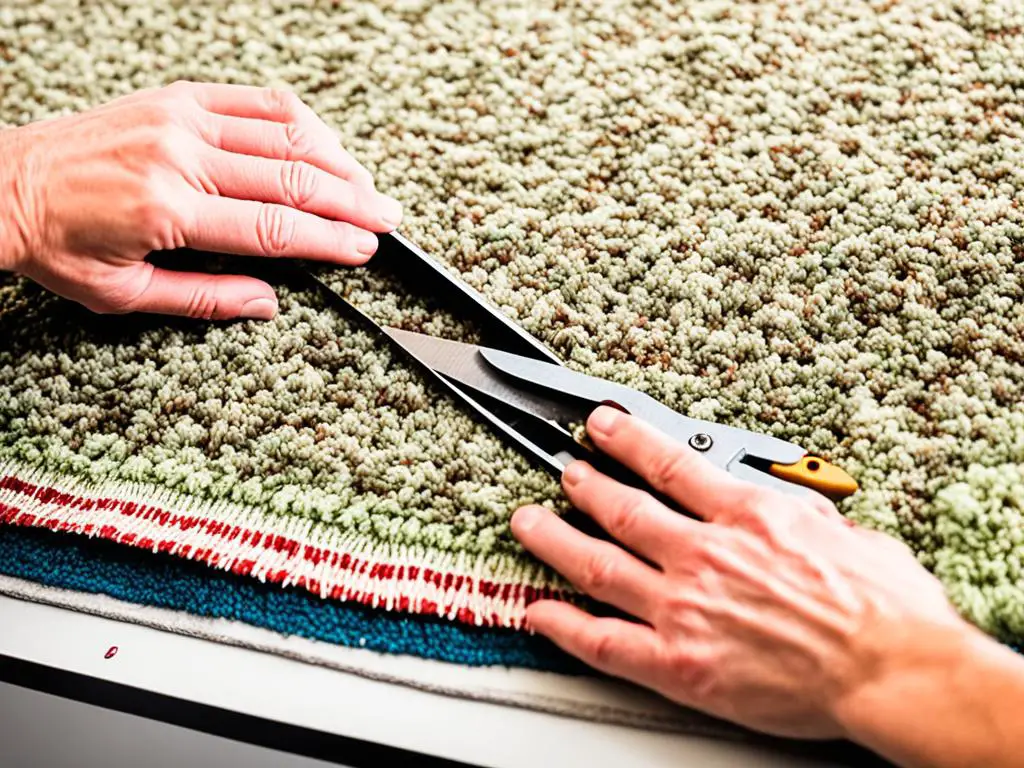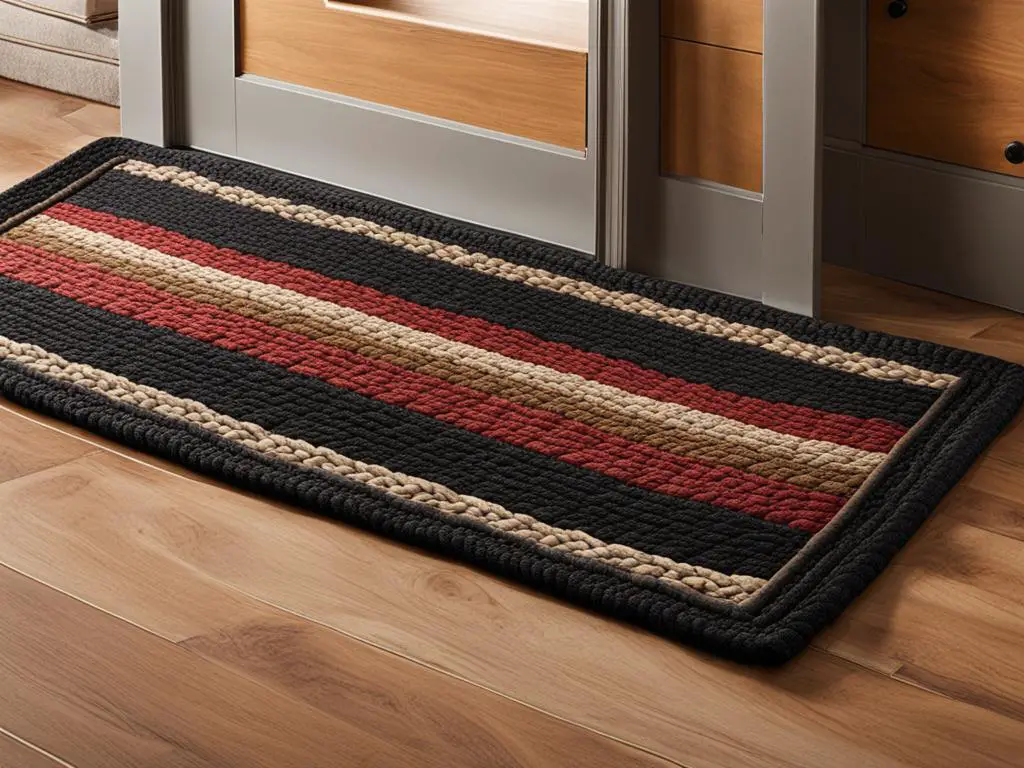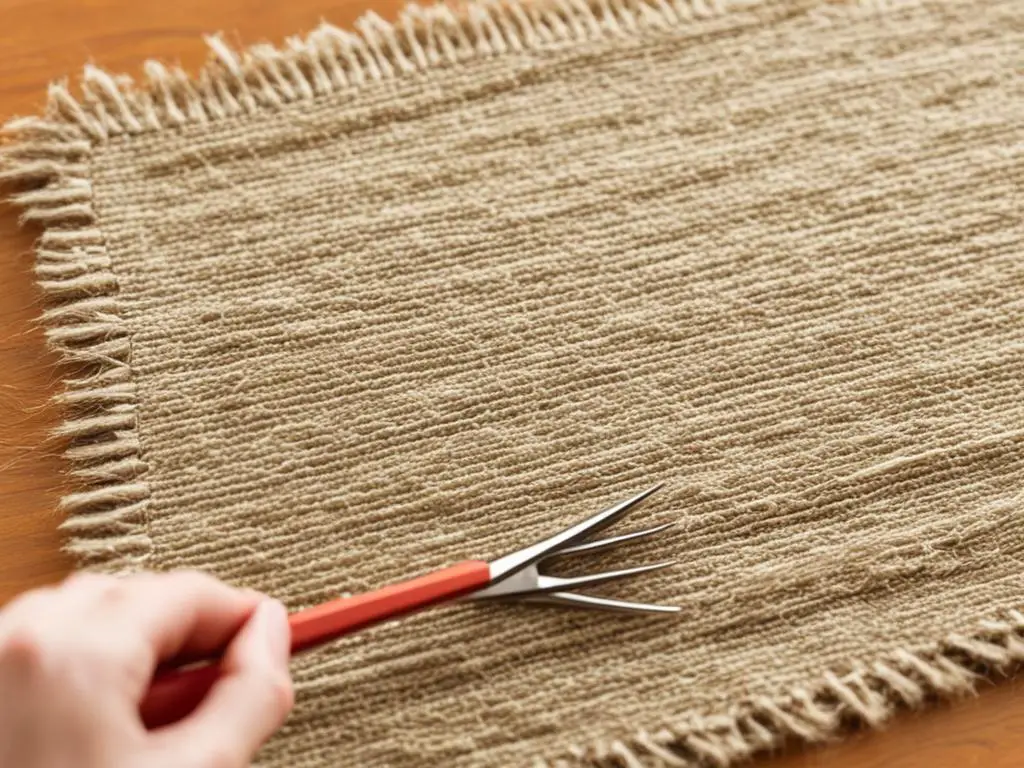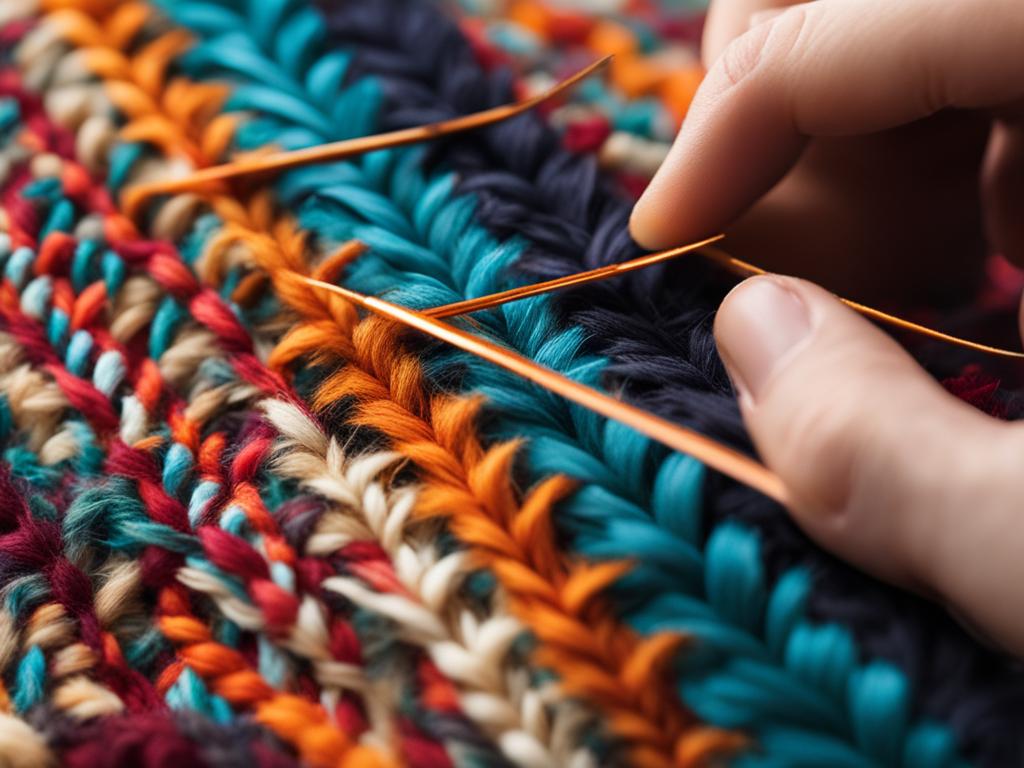Are the edges of your rug starting to come up and curl? Don’t worry, you’re not alone. Over time, rug edges can become frayed and damaged, compromising the appearance and longevity of your carpet. Whether it’s due to normal wear and tear or a mishap, it’s important to know how to repair a rug edge to prevent further damage.
Key Takeaways:
- Repairing rug edges is crucial for maintaining the integrity and aesthetics of your carpet.
- Improper cleaning, exposure to sharp objects, and improper storage can contribute to rug edge damage.
- Use a rug repair kit to cut off loose threads, apply glue, and sew remaining strands to fix a rug edge.
- For valuable rugs or major repairs, it’s recommended to seek professional assistance.
- By taking care of your rug edges, you can ensure that your rugs look their best and last longer.
How to Repair a Cut in a Rug
If your rug has a cut or tear, it is important to address it promptly to prevent further damage. There are a few methods you can use to repair a cut in a rug.
If the cut is small and on the back side of the rug, you can patch it with tape. Carefully align the edges of the cut and apply a strong adhesive tape to securely seal the tear. This temporary fix will provide some stability until a more permanent solution can be implemented.
For a more durable repair, you can sew the frayed edge of the rug. Start by using a putty knife to gently push the fabric back through the tear, aligning the edges as you go. Once the edges are aligned, secure the cut with tape to hold it in place. Then, using an upholstery needle and heavy-duty thread, sew over the edge of the rug starting about 1/4 inch from the damage. Make sure to wrap the thread around the frayed area until it is completely covered. This will create a strong, seamless repair that will help maintain the rug’s appearance and prevent further fraying.
Step-by-Step Guide: How to Repair a Cut in a Rug
- Assess the extent of the cut or tear in the rug.
- If the cut is small and on the back side of the rug, apply adhesive tape to patch the tear.
- If the cut requires sewing, align the edges of the cut using a putty knife. Secure the cut with tape.
- Thread an upholstery needle with heavy-duty thread. Start sewing about 1/4 inch from the damage.
- Make tight stitches over the edge of the rug, gradually wrapping the thread around the frayed area.
- Continue sewing until the frayed area is covered and the edges are securely connected.
- Trim any excess thread and inspect the repair to ensure it is secure.
Remember, it is always advisable to seek professional help for valuable rugs or major repairs. A professional rug technician can provide expert guidance and ensure a perfect result, especially for intricate or delicate rugs.
By following these steps, you can effectively repair a cut in a rug, restoring its integrity and preventing further damage.
| Rug Repair Methods | Pros | Cons |
|---|---|---|
| Tape patching | – Quick and easy solution – Temporary fix for small cuts – Requires minimal tools |
– Not suitable for larger or visible cuts – Adhesive may not hold over time |
| Sewing the frayed edge | – Provides a more permanent repair – Restores the rug’s appearance – Prevents further fraying |
– Requires sewing skills and tools – Time-consuming for larger cuts or delicate rugs – May not be suitable for very old or fragile rugs |

How to Repair a Braided Rug
If you have a braided rug that is coming unbraided, it’s essential to repair it promptly to restore its structure and stability. The process involves removing damaged stitches, unwinding the rug, and reattaching the worn or damaged material as a continuous braid. Here’s a step-by-step guide on how to repair a braided rug:
- Start by carefully examining the rug to identify areas where the braid is coming undone or damaged.
- Once you’ve located the damaged sections, gently remove the stitches holding the braid together using a pair of small scissors or a seam ripper.
- Unwind the rug until you reach the worn or damaged material. Take care not to unravel the rest of the braid during this process.
- Inspect the worn or damaged material. If it’s beyond repair, replace it with a new section of the same material or a closely matched alternative.
- Using an upholstery needle and linen thread, carefully resew the coil of the braid together, making small and tight stitches. Ensure that the stitches are strong enough to hold the braid securely in place.
- To reinforce the outer edges of the rug, attach a strip of cotton binding tape to the perimeter. Use small and tight stitches to secure the binding tape, ensuring it blends seamlessly with the rest of the rug.
By following this rug edge reinforcement and sewing technique, you can effectively repair a braided rug and prevent further unraveling. Remember to take your time and work meticulously to achieve the best results.

Example of a Braided Rug Repair:
Here’s an example of how the rug edge repair process would look:
| Step | Description |
|---|---|
| 1 | Identify the damaged sections of the braided rug. |
| 2 | Carefully remove the stitches holding the braid together. |
| 3 | Unwind the rug until you reach the worn or damaged material. |
| 4 | Inspect the damaged material and replace it if necessary. |
| 5 | Use an upholstery needle and linen thread to resew the coil with small, tight stitches. |
| 6 | Attach a strip of cotton binding tape to reinforce the outer edges of the rug. |
By following these steps and employing the rug edge sewing technique described, you can successfully repair a braided rug and extend its lifespan.
How to Trim and Bind a Jute Rug
If the edges of your jute rug start to fray, it’s important to take action to prevent further fraying. Fortunately, there is a simple technique you can use to trim and bind the edges of your rug, ensuring its appearance and durability are maintained.
To begin, gather a pair of heavy-duty shears, which will provide the necessary strength to cut through the frayed edge of the rug. Carefully trim away any loose or frayed threads, ensuring a clean and even edge.
Next, cut a strip of cotton binding tape that is slightly longer than the raw edge of the rug. The binding tape will serve as a protective barrier, preventing further fraying and adding stability to the edge.
Starting at one end of the rug, fold the binding tape over the edge and position it in place. To secure the binding tape, use cross-stitches through both the binding tape and the rug. This stitching technique will create a strong and durable bond between the tape and the rug.
Continue folding and stitching the binding tape along the entire length of the rug’s edge, making sure to maintain an even and secure attachment. Once you reach the opposite end of the rug, fold the end of the binding tape under the rug and secure it with cross-stitches as well.
This simple yet effective technique will help prevent further fraying of the rug’s edges and ensure its longevity. By taking the time to trim and bind your jute rug, you’ll be able to enjoy its beauty and functionality for years to come.

The Benefits of Trimming and Binding a Jute Rug
Trimming and binding a jute rug offers several benefits:
- Prevents further fraying: By trimming away frayed threads and adding a protective binding, you can stop the fraying process and maintain the integrity of the rug’s edges.
- Enhances appearance: A neatly trimmed and bound edge gives your jute rug a polished and finished look, enhancing its overall aesthetic appeal.
- Improves durability: The binding tape acts as a reinforcement, strengthening the rug’s edges and increasing its resistance to wear and tear.
- Easy maintenance: Trimmed and bound edges are easier to clean and maintain, as there are no loose threads or frayed areas that can trap dirt and debris.
Conclusion
Repairing a rug edge is crucial to maintain the integrity and appearance of your carpet. Whether you’re dealing with a cut in the rug, frayed edges, or a braided rug coming unbraided, there are effective repair techniques to address these issues. By utilizing a rug repair kit, tape, needles, and thread, you can restore your rug’s edges and prevent further damage.
However, for valuable rugs or major repairs, it is highly recommended to seek professional help. Experienced rug repair specialists have the expertise and tools necessary to ensure a perfect result. They can provide expert solutions for rug edge repair, curling, and restoration that will preserve the beauty and longevity of your rugs.
By taking proactive care of your rug edges, you can maintain their pristine condition and extend their lifespan. Regular inspection, prompt repairs, and correct maintenance will help prevent issues such as fraying, curling, and unraveling. With proper rug edge maintenance, your rugs will continue to bring warmth and elegance to your home for years to come.



